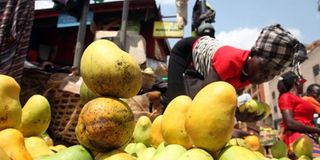Countries to ratify Tripartite Free Trade Area this month

A trader arranges mangoes for sale at Nakasero Market. The Tripartite Free Trade Area will benefit member countries in a way that they won’t have many complex rules to comply with. PHOTO BY STEPHEN WANDERA
What you need to know:
Dr James Mangeni is the director of trade, customs and monetary affairs at the Common Market for Eastern and Southern Africa (Comesa). Prosper magazine’s Jonathan Adengo caught up with him on the sidelines of the Comesa Competition Commission workshop in Livingstone, Zambia and got his views on the Tripartite Free Trade Area.
What is the Tripartite Free Trade Area (TFTA) all about?
The Tripartite Free Trade Area (TFTA) includes the 26 countries that are members of the Common Market for Eastern and Southern Africa (Comeas), East African Community (EAC), and Southern African Community (SADC). The TFTA covers a population of 632 million and a combined Gross Domestic Product of $1.3 trillion. The area spans 17.3 million square kilometres, which is nearly twice the size of China or the United States.
How did the Tripartite Initiative come about?
The Tripartite Initiative has a history. It started in 2001 to deal with multiple memberships in the Regional Economic Communities (RECs). Comesa was formed in 1994. However, by the time the agreement for the formation of Comesa was 1993, SADC had already been formed in 1992. When Comesa was formed, the Comesa people said SADC should be shut down so that they could have the COMESA only. There was a war at level of CEOs and countries such as Botswana and South Africa which never joined COMESA.
After these disagreements, it was agreed that there needed to be collaboration and cooperation in order for programmes to be similar as much as possible. By 2001, some progress had been made in terms of cooperation. There was a meeting in Egypt and the presidents talked about how to scale up their cooperation and had a gentleman’s agreement to formalise it.
In 2005, the East African Community was brought on board as the third organisation for cooperation. That name Tripartite was adopted when the EAC came on board, making the number of trade blocks to three. A further review was done in 2007 and a summit of heads of state and government was called leading to the first Tripartite summit in October in 2008 in Kampala hosted by President Museveni. That summit issued a communiqué which said the three organisations should merge and form one organisation but gradually, starting with a Free Trade Area, then moving towards a common market where there is free moving of goods and people.
What are the milestones achieved so far?
Following that directive in 2008, the secretariat started drafting the instruments for the Free Trade Area. Reviews were done and by 2011, there was consensus after consulting with all the countries that now negotiations can be launched. On June 12 in 2011, negotiations for the tripartite were launched and on June 10, 2015, the Tripartite Free Frade Area was launched using two instruments. Now we have a total of 20 countries out of 26 who have signed the tripartite agreement.

James Mangeni
How did you address the conflicts of interest that arise with multiple memberships?
The first issue was to address that problem of people who were in more than two trading organisations and they have conflicting rules such as standards and rules of origin, by having a single regime covering all the three organisations.
The second reason was the traditional agreement that the bigger the market, the bigger the economy because you have economies of scale. Therefore, higher levels of production creating more jobs.
The third was the strength of numbers, the more you are, the stronger you are.
How will the Tripartite Free Trade Area benefit the countries?
The practical benefit of having a single regime throughout the 26 countries is transparency and predictability. The most important is that you don’t have all these complex rules to comply with which may be even contradictory.
The second practical benefit is as a group you are stronger and bigger as one. The prospects for the larger markets and supporting infrastructure will spur industrial development. This will not only create jobs but it will also have the added advantage of diversifying Africa’s economies that are largely dependent on raw materials. The associated technological development will lead to the creation of new industries.
Trade among the three blocs over the last decade has been dominated by intermediate products and manufactured goods, contrary to the common belief that African countries are trading in similar. These trends underscore the potential role of the TFTA as a driver of industrial development and in the manufacture of high-value products.
The creation of larger markets will also help to stimulate trade in services. The first beneficiary is likely to be the financial sector, which will be able to lend to larger industrialists seeking to benefit from economies of scale. Such financial services will reinforce the increase in cross-border investments by emerging African firms that are serving as regional champions of industrial development.
Is there a timeline for achieving the Free Trade Agreement under Tripartite arrangement?
When the ministers met, a deadline of October 30, 2017 was set for the agreement to be ratified. However, two deadlines have been missed before, the first one was when the agreement was signed in 2015, a deadline of June 2016 was set but it was missed. So a new one of February was set but it was also missed leading up to the new one for October 30, 2017.
During the Tripartite FTA meeting that took place in Kampala in July 2017, the three regional blocs (EAC-COMESA-SADC) finalised and the adopted the remaining annexes on the Rules of Origin, Trade Remedies and Dispute Settlement, thus producing a full Tripartite Agreement.
All these outstanding issues were finally resolved and we hope that countries can now begin ratifying.




